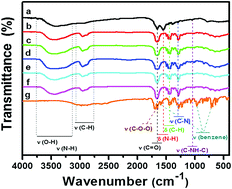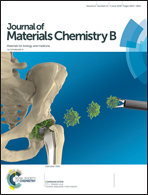Luminescence carbon dot-based nanofibers for a water-insoluble drug release system and their monitoring of drug release
Abstract
Drug release systems with fluorescence detection have emerged as a potential application for the biological area of diagnosis and therapy. Carbon dots (CDs) are a promising fluorescence probe for application in a drug release system due to their excellent biocompatibility, low toxicity, chemical inertness, and non-blinking fluorescence emission. Herein, we developed a composite nanocarrier based on fluorescent CDs and polyvinylpyrrolidone (PVP) through an electrospinning technology. The as-prepared PVP/CD–ketoprofen (PVP/CD–KET) composite nanofiber presents bright blue-light fluorescence with a photoluminescence quantum yield (QY) of 65.7% and was utilized for loading a water-insoluble drug and moreover for monitoring the drug release process. In vitro tests indicate that the photoluminescence emission intensity of the CDs and the cumulative amount of KET released from the PVP/CD–KET composite nanofiber gradually increase with the release time. Furthermore, the emission intensity of the CDs as a function of the cumulative released amount of KET can be summarized by a power function. The correlation between the emission intensity of CDs and drug release amount can be potentially used to monitor the drug release process.



 Please wait while we load your content...
Please wait while we load your content...